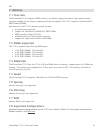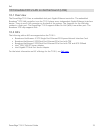
Dell
PowerEdge T110 II Technical Guide 30
9 BIOS
9.1 Overview
The PowerEdge T110 II BIOS supports ACPI and power management features.
9.2 Supported ACPI States
The PowerEdge T110 II BIOS is compliant with ACPI version 2.0a.
9.2.1 Power Management
Power management features come in two types: fixed or generic. Fixed features use bits defined in
the ACPI specification for specific capabilities. The fixed feature bits give the OS complete control
over the power management of a device, since the location of the bits is given to the OS in the FACP
table. Thus, a driver can directly access bits to control a device‘s power management. Generic
features have defined enable and status bits, but the functionality is not fully visible to the OS. Dell
provides ASL code to handle the details of generic features, allowing the OS to intelligently
communicate with system-specific hardware.
Table 10 summarizes the power management features on this system:
Power Management Features Table 10.
Feature
Type
Enable/Status/
Ctrl bit location
Description
ACPI Mode Switch
Fixed
PCH
The OS uses the SCI_EN bit in
PCH to switch from legacy
mode to ACPI mode.
Sleep States
Fixed
PCH
Supported states: S0
(Working), S4-OS
(‗Hibernation‘), and S5 (Soft-
off).
S1 (also called standby or
suspend) and S3 are not
supported.
Power Button
Fixed
PCH
In ACPI mode, OS has control
of the power button. In non-
ACPI mode, SMI handler owns
power button events.
Real-Time Clock
Fixed
PCH
The OS is able to configure the
system to wake on the RTC
alarm.
Power Mgmt.
Timer
Fixed
PCH
PCH 32-bit power management
timer is used
Power Mgmt. Event
(PME)
Generic
PCH
When a device signals PME, the
system wakes (if necessary),
the OS detects the event, and
a Dell-defined ASL routine
handles the event. Wake-on-
LAN is one example of a PME.


















